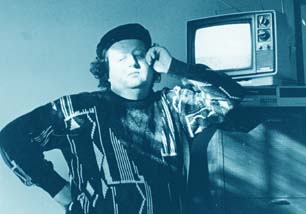Digital documentary
Julia Erhart

Peter Wintonick
Interested in the future of Australian documentary? Curious about the worlds of hacktivists and viewsers? The 2-day Digi Docs event was the place to be. With sessions costing less than the price of a Tuesday Cineplex ticket, Digi Docs broke new ground in bringing together, for the first time, a range of new media practitioners, broadcasters and critics to explore the effects of the digital revolution upon the world of documentary. Co-funded by the SAFC, the AFC, the Canadian Consulate and DFAT and curated by documentary maker Heather Croall (with assistance from Chris Joyner), Digi Docs was underpinned by two assumptions. One is that there exists an underexplored yet fruitful relationship between documentary and digital media, whereby the social impulses of the former are served by the participatory capacities of the latter. As became increasingly clear throughout the weekend, many digital practitioners are already behaving in ways that documentary practitioners always have–for example, acting as watchdogs over processes of information dissemination. The second assumption was the power of the national funding bodies to drive changes in the current Australian mediascape.
Friday’s events, entitled “Through Australian Eyes”, especially looked at this theme, with presentations from SBS, ABC, AFC, FFC, Channels 7 and 9 representatives about developing opportunities for practitioners, like the scheme for soon-to-be-completed on-line docos from ABC and the AFC. Issues practical and philosophical were hashed out, such as the role of the public media re: the digital divide and the real meaning of “interactivity” (more, presenters insisted, than the mere clicking of a button)–all of which I took as a sign of the still flexible state of play in both digital media policy and function.
If “Through Australian Eyes” was long on national developments, Saturday’s sessions surfed an international wave of digital arts, information, and activism. Co-curated by Banff Executive Producer for Television and New Media Sara Diamond and documentary practitioner Peter Wintonick (director of Manufacturing Consent and the more recent Cinema Verite), “Windows on the Real” identified 4 prevalent new media themes: the participatory culture of new media, surveillance, activism, and the potentially disruptive agency of some digital practitioners. New media showcasing old agendas were foregrounded (for example, the Witness site, www.witness.org; the Universal Rights Network, www.universalrights.net), while DIY and tactical sites also attracted attention. Want to put together a new flag (call by netflag.guggenheim.org/netflag/)? Or perhaps psychoanalyse your harddrive (visit, at your peril, www.maryflanagan. com/virus.htm)? Sites were shown evidencing these and other activities, as well as one that apparently re-directs Disney visitors to a local porn site (check out www.RtMark.com, though that site’s as much about future interventions as it is about realised ones—so you may have trouble finding it). Indymedia’s yet-to-be-launched Woomera 2002 site, which will automatically turn ordinary citizens’ telephone reports into printed text and then record the reports on to the site, promises to take notions of interactivity into brave new democratic terrain. Semi-autobiographical work by YH Chang (www.yhchang.com/), Melinda Rackham (www.subtle.net), and Sara Diamond (www.codezebra.net—with John Tonkin) rounded out the day, all in all making for an excellent and informative bringing together of what is arguably Screen’s very oldest formation with its very newest one.
Adelaide Fringe festival, Digi Docs, curator Heather Croall, Union House, Adelaide University, March 15-16
RealTime issue #48 April-May 2002 pg. 23






